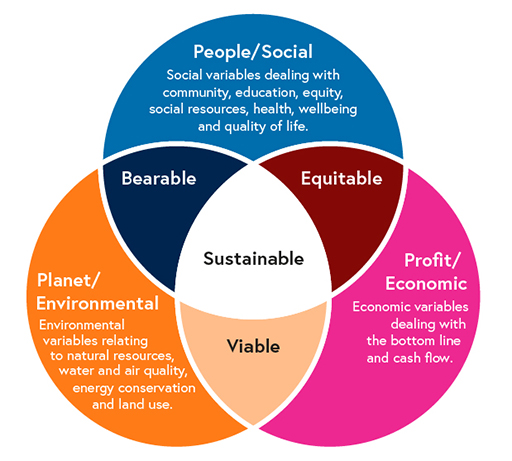3.5 Sustainable development
At the start of the course, we introduced hybrid ways of working: a contextual framework which suggests:
- You and how you work need to be mindful of the key stakeholders within your environment and their needs in relation to organisational development.
- You need to understand organisational needs, the context, connections, and requirements for key areas of focus and how these relate to the needs of your stakeholders.
- You need to consider your ways of working for the wellbeing of future generations.
The framework draws on the Triple Bottom Line (Elkington, 1994), and has been designed to assist with ensuring that wellbeing is an integral part of developing your organisation’s approach to sustainability, by considering the three pillars of sustainability: Social/People, Environmental/Planet, and Economic/Profit. They are of equal importance.
People/Social – Organisations ensure responsible, ethical, and fair treatment of employees, stakeholders, and the community it operates in.
Planet/Environmental – Promoting activities that lead to the reduction of negative impact on the environment, both within the organisation and its supply chain.
Profit/Economic – An organisation needs to be profitable in order to operate.
In the video Stephen Peake explains the triple bottom line for sustainability. As you watch consider how it might assist you in embedding three pillars of sustainability within your organisation.

Transcript
Developing a sustainable organisation may require decisions on profit margins. Committing to sustainable business practices requires change, and demonstrating the ‘environmental, social and governance’ (ESG) metrics are as equally important as the financial data, for measuring the success of organisations.
Many HEIs belong to The Alliance for Sustainability Leadership in Education [Tip: hold Ctrl and click a link to open it in a new tab. (Hide tip)] , which provides numerous resources, including the Higher Education Supply Chain Emissions (HESCET) Tool for helping with procurement decisions.
The triple bottom line: what it is & why it’s important article from the Harvard Business School Online explains what organisations need to consider for measuring their social and environmental impact.
Activity 8: How can HEIs assist in meeting the Well-Being of Future Generations (Wales) Act 2015 well-being goals?
‘The Well-being of Future Generations Act requires public bodies in Wales to think about the long-term impact of their decisions, to work better with people, communities and each other, and to prevent persistent problems such as poverty, health inequalities and climate change.’
Drawing on the information and your own research, how can HEIs develop sustainable practices, focus on the wellbeing of those within the organisation, and collaborate to ensure that long-term decisions provide better outcomes for future generations?

